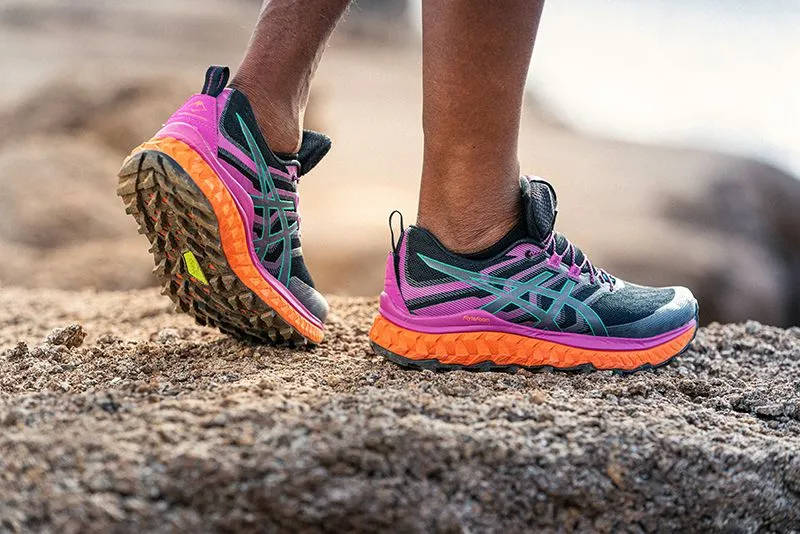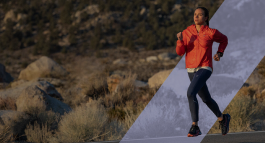
The Different Types of Running Shoes Explained
February 21, 2025
Explore the different types of running shoes with ASICS' detailed guide. Find the perfect fit for your running style and needs. Ideal for every runner.
When you visit sportswear stores, you’ll come up against walls of multicoloured footwear - all with unique features and designs. There are dozens of kinds of running shoes available today, so deciding which is right for you can be confusing.
To help you choose the right kind of footwear, this guide will introduce you to all the main running shoe categories.
Why it’s important to choose the right kind of running shoes
At first glance, most running shoes look fairly similar. But dig a little deeper, and there are some major differences between them. Research shows that the features included in different types of running shoes can have a significant impact on how efficiently you run and how much energy you use.
Learning about different types of running shoes will mean you choose footwear that’s comfortable, supportive, and which helps you run in the way you want.
6 key types of running shoes
We’ve listed six of the main types of running shoes, with examples.
1. Road running shoes
Road running shoes are the most common kinds of running footwear. As the name suggests, they’re built specifically for running on roads, and they’re also suitable for use on treadmills.
For most of human history, people would have run on bare earth, which is generally fairly soft. But today, people mainly run on tarmac or concrete. These are, of course, extremely hard surfaces. Road running shoes come with a variety of features that reduce the shock of running on these hard surfaces.
Look at a road running shoe, and you’ll notice a few key features:
- Cushioning: You’ll find lots of cushioning in the heel and midfoot to absorb the shock of footstrikes.
- Grip pattern: The grip pattern on running shoes is one-directional. When running on roads, you're mainly travelling straight forward, so don’t need grip for side-to-side or backwards movements.
- Traction: The outsole of road running shoes is generally made of extremely tough rubber materials that can handle the friction.
- Lightweight: The uppers of modern road running shoes are made of extremely lightweight, breathable fabrics.
Road running shoe examples:
Dig deeper: How Are Running and Training Shoes Different?
2. Trail running shoes
If you mainly run on muddy paths, mountain tracks, or anywhere else off road, then trail running shoes are the way to go. This type of running shoe is built specifically to help you run safely and confidently over wet, slippery and uneven surfaces.
Pick up a trail running shoe, and you’ll notice several unique features:
- Chunky lugs: The soles of trail running shoes have big, chunky lugs. These allow you to grip on slippery, muddy surfaces.
- Water resistance: Many trail running shoes use breathable but water resistant materials in the uppers - a game changer when you’re splashing through puddles.
- Safety features: You may find features like rock protection plates in these shoes, which help you avoid injuries from jagged stones.
- More cushioning: Trail shoes tend to have more cushioning, distributed evenly across the sole of the shoe.
Trail running shoe examples:
Related: Get into nature with trail running
3. Running shoes for pronation types
‘Pronation’ is a term that describes how a person’s foot moves when it comes into contact with the ground while running. There are, broadly speaking, three pronation patterns. Footwear manufacturers build different running shoe categories for different pronation types.
Understand: The ASICS guide to pronation
Neutral pronation
This is the most common kind of pronation - studies suggest 61% of men and 55% of women are neutral runners. When running with neutral pronation, your entire midfoot comes into contact with the ground, and you push off with all your toes at the same time.
Neutral running shoes have a few key features:
- Less cushioning: Cushioning is mainly found in the heel and midfoot.
- Flexible sole: These shoes have a slightly softer, more pliant sole, which lets the foot follow its natural motion.
- Lightweight: They’re some of the lightest kinds of running shoes.
Neutral running shoe examples:
Over pronation running shoes
Over pronation is when the inside of your foot comes into contact with the ground first, and you push off with your big toe. The outside of the foot may not come into contact with the ground at all. About one third of runners are overpronators, on average. Overpronation running shoes are designed to give extra support, to help avoid injuries.
Key features of this type of running shoe include:
- Medial support: Overpronation shoes often use a section of harder foam in the midfoot area. This offers additional support underfoot.
- Firmer sole: The entire sole will be firmer and less flexible than with neutral running shoes.
- More cushioning: You’ll find maximum cushioning in these shoes - so the foam or GEL absorbs more force - rather than your ankles or knees.
Supination running shoes
Finally, supination (also known as under pronation) is when the outside of your foot comes into contact with the ground first. You then push off from your little toes. The inside of your foot may never come into contact with the ground. Often, neutral running shoes are suitable for supinators - but it’s valuable to choose footwear that maximises cushioning.
Key features of supination running shoes include:
- Cushioning: These shoes really maximise cushioning. Since the outside of your foot is absorbing more force, having extra cushioning reduces the impact on your body.
- Wider toe box: Foot pain from conditions like plantar fasciitis is common in people who supinate. Having a wider toe box allows your toes to spread, making them more comfortable.
Supination running shoe examples:
4. Wide fit running shoes
Men’s and women’s running shoes are made for an ‘average’ foot shape. But, of course, everyone is different, and sometimes standard widths feel too tight. Some people naturally have wider feet, while others may have flat arches or a foot condition such as bunions which means they need more space.
There are various types of running shoes for wide feet. Key features include:
- Wider toe box: Having a wider toe box gives your feet more space to spread.
- Flexible uppers: Wide fit running shoes typically use mesh uppers that have some ‘give’. This allows your foot to be held snug in place, but without feeling crammed in.
- Wider last: Wide fit running shoes are built around a slightly wider last.
Wide fit running shoe examples:
5. Fast running shoes
If you’re looking to increase your pace, then there are several types of running shoes that are built for speed. They are, unsurprisingly, very lightweight, but they also provide several other features:
- Carbon plates: The use of carbon plates in some fast running shoes helps propel you forward with every step.
- Sole shape: Fast running shoes often have a slightly curved sole.
- Energised cushioning: The cushioning in many fast running shoes is often built using special kinds of cushioning that add more bounce to each stride.
Fast running shoe examples:
Try running shoes in person: Visit an ASICS store for guidance from our specialists
What type of running shoe do you need?
There are many different kinds of running shoes out there - and the choice can be confusing at first. But, by learning about the main types of running shoes - and the sorts of activity they’re intended for - you’ll be able to narrow down your search and choose the right pair for you.
To help decide between different types of running shoes, use our Shoe Finder. Answer four quick questions, and it will suggest shoes that are best suited to your needs.
